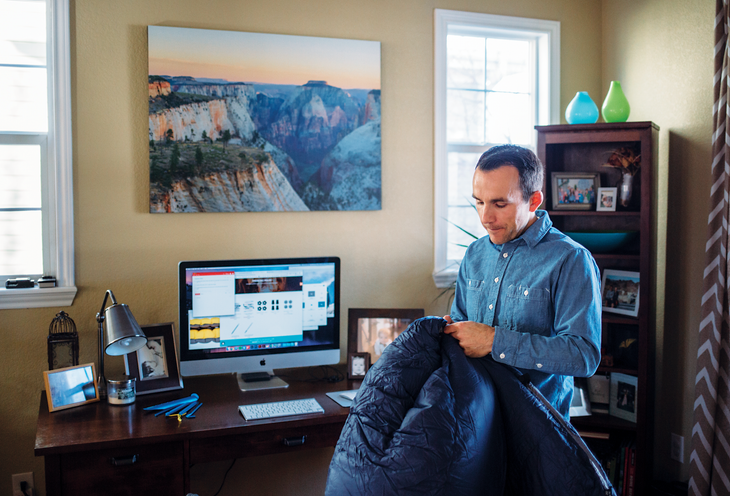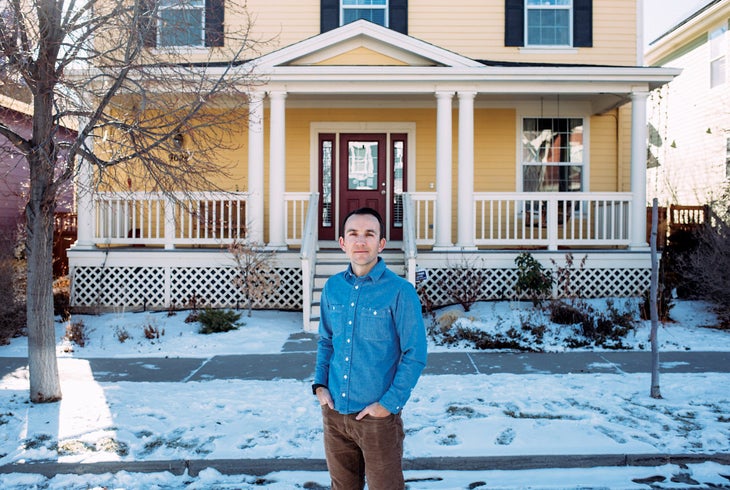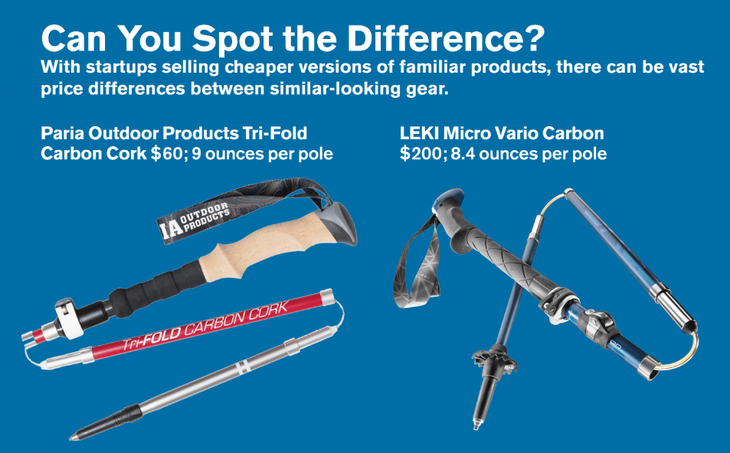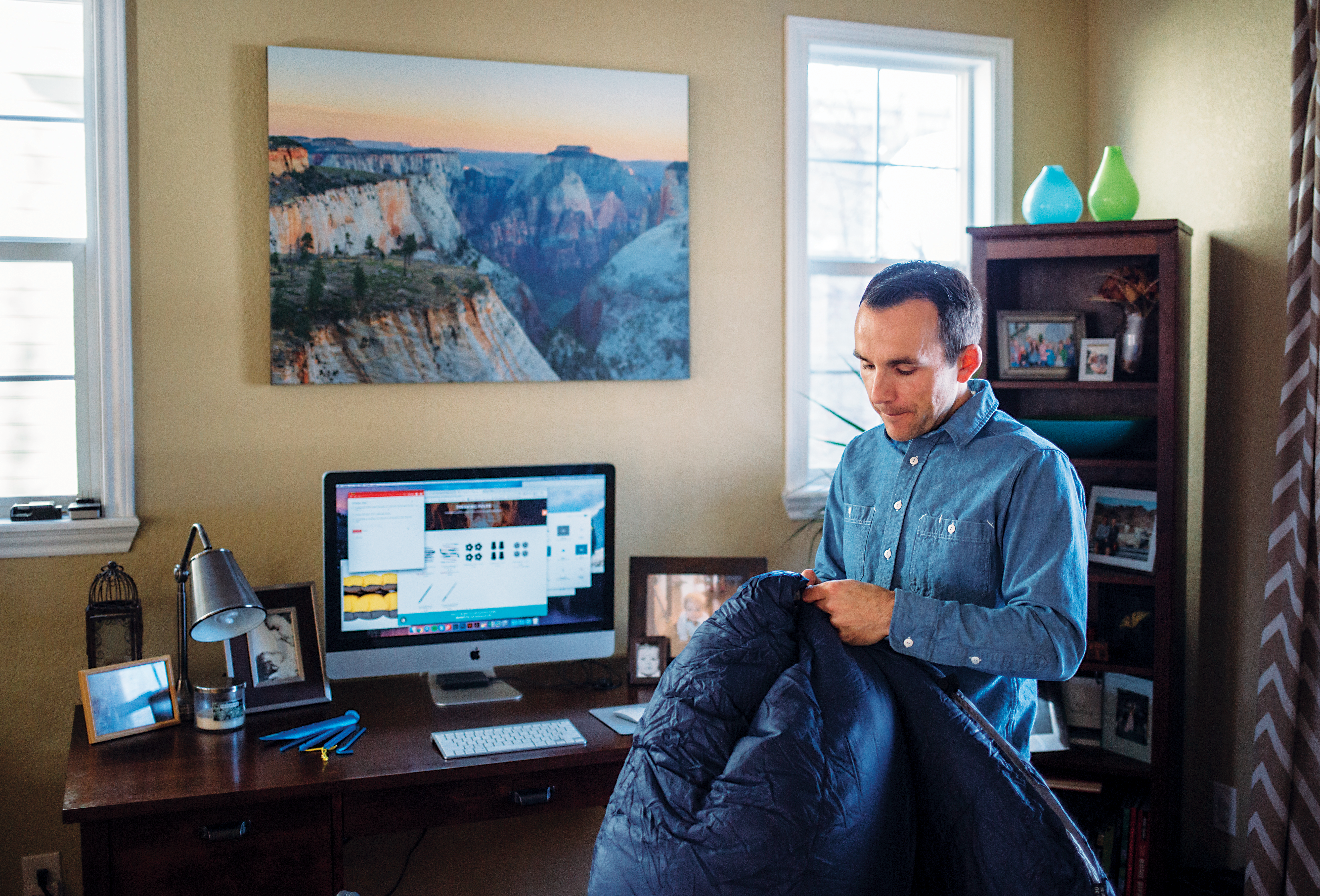There was a time in Tayson Whittaker’s life when $200 was a lot of money. In 2014, when Whittaker was a 23-year-old finance student at Southern Utah University, he struggled to come up with enough cash to buy ultralight backpacking gear. He already had a closet full of hunting and fishing equipment that he’d acquired as a kid growing up in rural Richfield, Utah, but his college pals had turned him on to hiking—and the comforts that come with lightweight gear. Even the Kelty Cosmic (the cheapest down sleeping bag he could find) cost almost two Benjamins, which Whittaker couldn’t afford.
Most people, faced with a similar situation, would make do with eBay and move on. But Whittaker had another idea. If no gear company sold the product he wanted at a price he could afford, why not launch a brand that would? After all, he’d already taken loads of business courses, and had even peered into the direct-to-consumer world as a part-time employee with a health supplies importer. “I knew I enjoyed business, but wanted to get into something I was passionate about,” he said.

So with $500 in his checking account and a newly minted bachelor’s degree, Whittaker founded Outdoor Vitals. In this case, “founded” meant establishing an LLC and a website, becoming an Amazon seller, and placing an order (for just five units) with a manufacturer in Asia. No in-house designer, no marketing department, no sales reps—he couldn’t afford them, but he didn’t need them. He simply browsed the Chinese online database Alibaba until he found a factory that promised to make what he wanted: a down-filled sleeping bag that he could sell for less than $100.
In July 2014, he listed Outdoor Vitals’ first product on Amazon. His 500-fill Atlas mummy bag weighed a little more than three pounds, promised a 15-degree comfort rating, and cost consumers a whopping $99. His margin was 30 percent after Amazon fees.
It was an instant hit: Whittaker had to order more bags—a lot more—as the Atlas reigned as Amazon’s number one-selling sleeping bag for more than a year. Since then, Outdoor Vitals has expanded its “Live Ultralight” mission to include hammock-specific bags, backpacks, tarps and tents, and a synthetic-fill jacket. And Whittaker has more than $500 in the bank these days, with Outdoor Vitals selling more than $2 million in product annually.
The success of Outdoor Vitals was made possible by two key changes in the way gear is made and sold. First, the evolution of Asian manufacturing makes it possible to hand off design and materials sourcing to the factory. Communicating with factory management is also easier than ever, with email replacing the costly, face-to-face negotiations that were the norm as recently as ten years ago. Gear production is hardly an infant industry these days; it has grown up, with established norms and a sophisticated workforce.
And second: Amazon. There’s nothing new about the math of selling direct to consumers, but it used to take capital to reach those shoppers. Now, access to a nation of bargain-hunters is just a few clicks away.
Outdoor Vitals is not alone in pioneering this model. A growing number of similar upstarts are discovering this low-cost formula, and they can’t be written off as simply cheap. Many of their products please consumers: piles of five-star reviews confirm it. And, proponents argue, these brands are filling a gap in the marketplace for basic, affordable, functional outdoor gear. The low-investment model also makes it easier than ever for any hiker or climber to turn his or her passion into a business—a dream that has sparked many a career in the outdoor industry.
But critics point out that this emerging model hurts the industry by undercutting its retailers (though the same can be said of all direct online sales). And some accuse these startups of copycatting: instead of pioneering their own designs, company founders make small tweaks to existing products—which often look a lot like models that were developed and tested by established brands that invest in R&D.
So are these startups leeching off the industry’s innovators? Or does the model democratize outdoor gear by giving consumers affordable, basic options—and offering scrappy entrepreneurs a low-investment way to get in the game?
After a 17-year career as a civil transportation engineer, Bart Przybyl quit his job. He simply didn’t have time to report to the office anymore, because his company, Paria Outdoor Products, was growing so fast. When Przybyl founded Paria in October 2015, he intended it to be a sideline business that would bring in enough supplemental income to let his wife stay home with their three kids. But two years later, with the “side business” grossing more than $1 million annually, Przybyl decided it was time to make gear his main gig.
It all started with a podcast that Przybyl heard one day while creeping through traffic in Denver. The interview, with someone who’d started an e-commerce business, inspired Przybyl to leverage his passion for backpacking into launching a gear brand. As a kid growing up in Vancouver, Przybyl went for a weeklong trek on British Columbia’s West Coast Trail, and he has loved backpacking ever since. His first desert adventure, in Utah’s Paria Canyon, inspired the name of his company.
Like Whittaker, he searched through Alibaba’s database, then listed the specs he wanted for a trekking pole and asked a few factories to send him their samples. “I’ve used poles for a long time, and appreciate their benefits for backpacking,” Przybyl explained. But the folding style that he prefers (because it packs shorter than telescoping models) costs $100 to $200 from brands such as Leki, Helinox, and Black Diamond. So Przybyl set out to make a cheaper version: “Maybe not as high quality, but good enough,” he said. This philosophy—that a lot of backpackers just need gear that’s “good enough”—is key to his approach. So he selected his favorite factory-direct sample, dictated a smattering of changes, and ordered 500 pairs. They arrived 40 days later, and on January 21, 2016, he made his first sale, for $55, on Amazon.
“Amazon has a program that lets you store your inventory at their distribution centers, and their staff picks and packs it,” said Przybyl, explaining his low overhead model. Amazon’s shoppers quickly took notice of Paria’s bargain-priced poles. “Sometimes, we’d sell 50 pairs a day,” Przybyl said. “So I got to wondering where to go next.”
Paria has since expanded into sleep systems, tents, and even double-walled titanium mugs. “We don’t have R&D,” said Przybyl. “We’re not developing products from scratch.” Instead, he targets basic, low-cost construction and asks himself, “Can I make some modifications to existing products to make them better?”

Judging from the glowing reviews (five stars each for Paria’s Thermodown 15 sleeping bag and Tri-Fold Carbon Cork trekking poles), Przybyl’s products typically please purchasers. “I love the sleeping pads that I bought,” raved one buyer. “They’re great!” Another attested, “I have pitched the [Sanctuary SilTarp] along the wilderness coast of Olympic National Park and in the Hoh Rainforest. It has performed flawlessly.” Indeed, Backpacker testers have favorably reviewed three of Paria’s products. No surprise, the prices are also a hit. “You are doing an awesome job of helping more people to get outside and play!” wrote one satisfied Paria customer.
“What I’m trying to do is fill a gap in the market,” said Przybyl. “There’s really good backpacking gear made by companies such as Nemo and Big Agnes, and they’re awesome brands, top quality, but expensive. Then on the flip side, there’s the really inexpensive gear that you find at Walmart that isn’t good for backpacking because it’s so heavy. It seemed like there was a spot in the middle for lightweight, quality gear that’s suitable for backpacking, but isn’t premium.”
But Greg Wozer, vice president of Leki USA, prefers to assume that all consumers need the best possible reliability—especially in his category of equipment. If a telescoping mechanism fails, or a pole shaft buckles, the user could fall. So even though there are no safety standards governing trekking pole design, Leki subjects all its poles to third-party testing to make sure that even its lowest-cost models exceed industry recommendations.
He also disputes the claim that big-name brands don’t offer entry-level options. “The idea that we only develop products for the elite could not be less true,” Wozer said. “Yes, it’s a challenge to continually renew those products at the top of the pyramid, but every time we do, it allows us to take those high-end qualities and filter them down to entry-level products.” Leki’s cheapest pair of poles (a telescoping model) costs $60, but its folding designs start at $140 per pair—and Paria sells its folding poles for $50 to $60 per pair.
But it’s not just about price, said Bill Gamber, founder and co-owner of Big Agnes. Product testing and research matter, he believes. Big Agnes prototypes go through multiple iterations, each one informed by extensive in-field use to make sure they’re ready for consumers. With factory-direct models that forgo that development process, paying customers become the guinea pigs.
Gamber added that brands with no R&D aren’t just skimping on testing: they’re ripping off standards that he and others established. “They’re selling someone else’s thought process and design and hard work.” In fact, he claimed, it’s inaccurate to say that factory-direct startups don’t use designers. “They do. It’s Big Agnes, or MSR, or Mountain Hardwear. They’re just not paying for it.”
Imitation is the sincerest form of flattery, and every industry has to accommodate it—and has since the second wheel was made. From smartphones to coffeemakers to cough drops, the trickle-down effect is a key part of market growth. Some companies prioritize innovation, while others target affordability. The mix of both creates a diverse marketplace that serves a range of consumers. Should the outdoor industry be any different?
In fact, many innovators actually welcome new ideas that challenge the status quo. “True competition spurs innovation and pushes us to be better,” Wozer said. But he points out that being part of the outdoor industry has always been about more than making widgets. Leki and most brands that are firmly part of the outdoor ecosystem support nonprofit trail associations. Many support conservation causes and outreach programs. Then again, most companies need to get their financial footing before ramping up donations. Outdoor Vitals currently donates 1 percent to environmental causes, and Whittaker said he plans to develop a more robust giveback program. Paria occasionally donates gear to the local Boy Scouts chapter and similar nonprofits.
Wozer also takes exception to the parasitic nature of some startups. Some Amazon sellers (not Outdoor Vitals or Paria) copy entire pages of educational content from the websites of established brands, and list products using keywords borrowed from the bigger names. “We’ll see listings that use the names of our best-selling models and features,” Wozer said. “They’re disingenuous in the way they present themselves to the consumer.” Thus Wozer isn’t convinced that Amazon shoppers are making fully educated purchases. Some bargain-priced lookalikes come so close to Leki’s original designs that even he can’t discern the difference at a glance. “But you can’t gauge tensile strength by appearance,” said Wozer. (It’s important to note that factory-direct brands are not all the same. Ones like Paria and Outdoor Vitals have customer service and product expertise, while the knockoff artists Wozer is referring to often don’t; we tried to contact several of the latter for this story, but none responded.)
Whittaker says that consumers don’t always get what’s advertised, but it’s not necessarily because companies are deliberately deceitful—they’re just ignorant. Sometimes sellers are copying features that they know nothing about, so they’re cavalier about the facts. When a competing company plagiarized Outdoor Vitals’ own product copy, said Whittaker, it labeled its 500-fill bag as 800-fill down. “They assumed that 90/10 [down-to-feather ratio] meant 800-fill,” said Whittaker. “Yet [the bags] still got five-star reviews, because customers didn’t know the difference.” (The copy was eventually corrected.)
Of course, imitation is not limited to low-cost companies. Take the folding trekking pole. Several leading brands now use this design, and you can bet they didn’t all invent it independently. Still, Gamber believes it’s important to bring something original to the table. When Big Agnes set out to develop its own lightweight camp chair, after years of distributing the Helinox version that enjoyed widespread popularity (and cloning), BA designers were careful to engineer their own, differentiating features—like bent poles and innovative joints. Still, it looks quite like the Helinox chair at a glance.
To make its own line of branded gear, REI Co-op employs a team of in-house designers that make sure each product bears REI’s brand DNA. “The majority of Co-op Brands product is ground-up concepted, designed, and executed by our creative team,” said general manager Paul Calandrella.
But, says Przybyl, some standbys don’t need to be reinvented every time. Paria’s 1P and 2P Bryce tents, for example, employ a widely used geometry. “It’s been around forever, and is offered by lots of other companies,” he said. “We’re not working with product that necessarily needs a designer to rethink it from scratch.”
In other words, nowadays a tent is like a water bottle: if you just want a basic model, the factories don’t need a lot of instruction.

For some startups today, the first contact with a factory is through Alibaba (tagline: “Global trade starts here”). The site publishes contact information for thousands of manufacturers and suppliers across a wide range of industries. Before Alibaba, you had to travel to Asian factories and negotiate designs and terms face to face, said Richard Amodio, a Bangkok-based production consultant and former factory manager who now advises brands on sourcing, design, and product development.
“These days, it’s easier to find [a factory],” Amodio said. But prospecting startups probably won’t be able to partner with the best factories, he claims, because those operations tend to work with bigger, established outdoor brands.
And while it’s possible to get quality work done, said Amodio, when you outsource everything to the factories, you outsource control. “It’s a gamble in so many ways, because you’ve got no control over how it’s made, where it’s made, or who’s making it,” he explained. From afar, low-cost startups can’t supervise quality control. They can’t evaluate materials to confirm that their second batch of fabric is as good as the first one. And they certainly can’t know whether the factory is following acceptable environmental and human rights practices, Amodio said.
Bigger brands dedicate significant resources to compliance—they make sure that materials, production methods, and working conditions comply with international standards and laws. And, of course, this is another factor that drives up price.
For example, Big Agnes employs two full-time quality inspectors, plus two more just for materials testing (the company verifies every batch of down to make sure it meets the declared fill rating). Each Big Agnes sleeping bag goes through a metal detector to make sure there are no needles lodged in the seams—because sewing needles sometimes break. Gamber doubts that ultra-lean startups are providing that kind of quality assurance. (Both Paria and Outdoor Vitals do quality-control inspections. Though their process may not be as thorough as ones used by larger brands, they back their products with a lifetime warranty against manufacturing defects.)
And Wozer noted that Leki has developed sustainable production methods that prevent chemicals from getting into waterways and capture waste aluminum for recycling. He said low-cost production methods may impose a higher environmental impact.
Przybyl disagrees, and disputes Amodio’s claim that startups and big brands don’t share factories. “Some of our products are made in the same factories as the big brands, so in those cases, [charges of environmental and social harm] are just not true,” he said. Whittaker also produces some of his products in factories that he shares with bigger brands, so he knows they adhere to higher standards. And at the smaller factory that Whittaker initially partnered with, he negotiated a five-day work week for his product line.
But factories are only part of the equation for this new breed of brand. The other part is direct-to-consumer distribution.
So far, companies such as Outdoor Vitals have found customers primarily through Amazon. But Amazon itself is getting into the game with its Amazon Basics line, and Whittaker expects that in the race for ultralow prices, the behemoth will ultimately beat out the independents.
Yet the model allowed Whittaker to turn $500 into a foothold in the outdoor industry, and now, he intends to climb. “Initially, my biggest selling feature was price,” he said, but as his prices rose, his visibility on Amazon plummeted. That’s OK, he says. “For me, Amazon was a stepping stone.” Now, Outdoor Vitals processes 50 percent of its sales through its own website (direct sales remain the goal). It has built a community of brand devotees through its YouTube channel, which has 15,000 subscribers. Whittaker is developing fresh product like the LoftTek ���ϳԹ��� Jacket, which uses a new synthetic fill and raised $750,000 in 35 days on Kickstarter. “I feel extremely blessed to be able to work in the outdoor industry,” he said. “As a kid, I never would have guessed I could combine my biggest passions into my everyday career.”
But Whittaker admits that he’s reaching the limits of the factory-direct model and will probably soon start hiring his own designers—initially on a contract basis, and eventually, he expects, as employees. “We now have way too many designs to keep doing it the way we have been,” he explained.
And that’s not the only sign that Outdoor Vitals is becoming more like the brands it once imitated. When competitors started knocking off Whittaker’s own products, he responded by moving into new territory. In July 2016 he debuted the Aerie underquilt for hammocks, and in July 2017 he developed (and patented) the MummyPod, a sleeping bag with a novel footbox design that slides over a hammock to provide insulation beneath the sleeper.
Within months, he saw cookie-cutter versions of both products appearing on Amazon.


